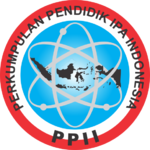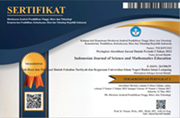Physics history e-module based on project-based learning integrated with Google Sites: Validity and practicality analysis
Abstract
Keywords
Full Text:
PDFReferences
REFERENCES
Al Fawareh, H. M. azer, & Jusoh, S. (2017). The use and effects of smartphones in higher education. International Journal of Interactive Mobile Technologies, 11(6), 103–111. https://doi.org/10.3991/ijim.v11i6.7453
Amamou, S., & Cheniti-Belcadhi, L. (2018). Tutoring in Project-Based Learning. Procedia Computer Science, 126, 176–185. https://doi.org/10.1016/j.procS.2018.07.221
Andanawarih, M., Diana, S., & Amprasto, A. (2019). The implementation of authentic assessment through project-based learning to improve student’s problem solving ability and concept mastery of environmental pollution topic. Journal of Physics: Conference Series, 1157(2). https://doi.org/10.1088/1742-6596/1157/2/022116
Azis, H., & Yulkifli. (2021). Preliminary research in the development of smartphone-based e-module learning materials using the ethno-STEM approach in 21st century education. Journal of Physics: Conference Series, 1876(1). https://doi.org/10.1088/1742-6596/1876/1/012054
Aziza, A., & Baroroh, K. (2024). Development of Google Sites-Based Social Science Learning Media to Increase Students’ Critical Thinking Ability. International Journal of Multidisciplinary Research and Analysis, 07(05), 1919–1923. https://doi.org/10.47191/ijmra/v7-i05-12
Bukhori, B., Said, H., Wijaya, T., & Nor, F. M. (2019). The effect of smartphone addiction, achievement motivation, and textbook reading intensity on students’ academic achievement. International Journal of Interactive Mobile Technologies, 13(9), 66–80. https://doi.org/10.3991/ijim.v13i09.9566
Chiu, T. K. F. (2021). Digital support for student engagement in blended learning based on self-determination theory. Computers in Human Behavior, 124(March), 106909. https://doi.org/10.1016/j.chb.2021.106909
Christina Ismaniati, & Baroroh Iskhamdhanah. (2023). Development of Interactive E-Modules to Increase Learning Motivation and Science Literacy in Elementary School Students. Jurnal Iqra’ : Kajian Ilmu Pendidikan, 8(1), 156–173. https://doi.org/10.25217/ji.v8i1.2699
Fadhilah, N., & Thahir, R. (2023). Development of Electronic Module with Project based Learning. Bioeduscience, 7(3), 350–357. https://doi.org/10.22236/jbes/11817
Ilmi, R., Arnawa, I. M., Yerizon, & Bakar, N. N. (2021). Development of an Android-Based for Math E-Module by using Adobe Flash Professional CS6 for Grade X Students of Senior High School. Journal of Physics: Conference Series, 1742(1). https://doi.org/10.1088/1742-6596/1742/1/012026
Jusriati, J., Nasriandi, N., Kurniadi, W., & Ratna, R. (2021). the Implementation of Google Site As E-Learning Platform for Teaching Efl During Covid-19 Pandemic. English Review: Journal of English Education, 10(1), 129–138. https://doi.org/10.25134/erjee.v10i1.5363
Kean, A. C., & Kwe, N. M. (2014). Meaningful Learning in the Teaching of Culture: The Project Based Learning Approach. Journal of Education and Training Studies, 2(2), 189–197. https://doi.org/10.11114/jets.v2i2.270
Lou, S.-J., Chung, C.-C., Dzan, W.-Y., & Shih, R.-C. (2012). Construction of A Creative Instructional Design Model Using Blended, Project-Based Learning for College Students. Creative Education, 03(07), 1281–1290. https://doi.org/10.4236/ce.2012.37187
Maryanti, E., Suminar, T., & . E. (2023). Development of Ethno-STEM E-Module with Project Based Learning Model Based on Yogyakarta Local Wisdom to Improve Student’s Creative Thinking Abilities. International Journal of Research and Review, 10(10), 105–114. https://doi.org/10.52403/ijrr.20231014
Millen, N. R., & Supahar, S. (2023). The Effectivity Study: Implementation of the Physics e-Module with PjBL-STEM Model to Describe Students’ Creative Thinking Skills and Learning Motivation Profile. Journal of Science Education Research, 7(2), 106–113. https://doi.org/10.21831/jser.v7i2.62131
Nursamsu, N., Mahyuny, S. R., Nafaida, R., & Rezeqi, S. (2023). Development of E-Book Based Instructional Design PjBL Model Integrated Science Literacy To Improve Critical Thinking Abilit. Jurnal Penelitian Pendidikan IPA, 9(9), 6896–6903. https://doi.org/10.29303/jppipa.v9i9.4948
Parmar, P., Patond, S., Rathod, G., & Ninave, S. (2020). Google site as a tool for teaching undergraduate students in forensic medicine. Indian Journal of Forensic Medicine and Toxicology, 14(4), 427–431. https://doi.org/10.37506/ijfmt.v14i4.11512
Rahman, M. H., Saprudin, S., Nana, N., & Adam, N. (2024). Development of Physics Teaching Materials Based on the Prediction, Observation, Explanation, Elaboration, Writing, and Evaluation (POE2WE) Learning Model Assisted by Google Site. KnE Social Sciences, 2024, 459–471. https://doi.org/10.18502/kss.v9i19.16534
Rahman, S. A. (2022). The Development of Mathematics E-Modules by Using Flip PDF Professional Software on Algebraic Forms of Material. Annual International COnference on Islamic Education for Students, 1(1), 460–469. https://doi.org/10.18326/aicoies.v1i1.264
Resmanti, P., Faridah, A., & Hendriyani, Y. (2024). Development of the E-module with Project-Based Learning for the Flat Pattern Design Course. 5(3), 408–416. https://doi.org/10.46843/jiecr.v5i3.1505
Yulkifli, Y., Yohandri, Y., & Azis, H. (2022). Development of physics e-module based on integrated project-based learning model with Ethno-STEM approach on smartphones for senior high school students. Momentum: Physics Education Journal, 6(1), 93–103. https://doi.org/10.21067/mpej.v6i1.6316
Zhang, L., & Ma, Y. (2023). A study of the impact of project-based learning on student learning effects: a meta-analysis study. Frontiers in Psychology, 14(July), 1–14. https://doi.org/10.3389/fpsyg.2023.1202728
Zhang, Z., Hansen, C. T., & Andersen, M. A. E. (2016). Teaching Power Electronics with a Design-Oriented, Project-Based Learning Method at the Technical University of Denmark. IEEE Transactions on Education, 59(1), 32–38. https://doi.org/10.1109/TE.2015.2426674
DOI: http://dx.doi.org/10.24042/ijsme.v8i1.25671
Refbacks
- There are currently no refbacks.
Copyright (c) 2025 Unit Riset dan Publikasi Ilmiah Fakultas Tarbiyah dan Keguruan Universitas Islam Negeri Raden Intan Lampung

This work is licensed under a Creative Commons Attribution-ShareAlike 4.0 International License.

Indonesian Journal of Science and Mathematics Education is licensed under a Creative Commons Attribution-ShareAlike 4.0 International License.




